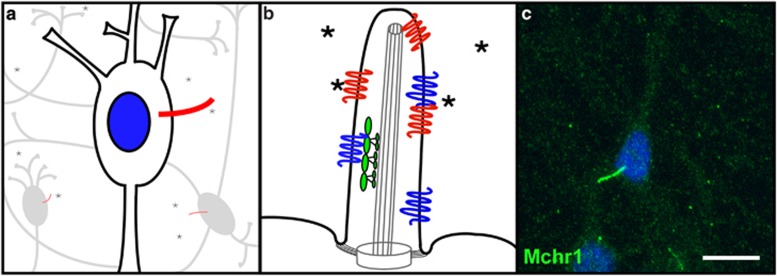The human brain is comprised of billions of neurons that communicate with each other through an intricate web of axons and dendrites. However, more and more research suggests that neurons may also sense and respond to their environment via a specialized organelle called a primary cilium (Green and Mykytyn, 2010). Primary cilia are typically solitary, microtubule-based appendages that project from the surface of nearly every cell type in the human body, including most neurons throughout the brain. The primary cilium is thought to act as an antenna surveying the extracellular milieu, receiving various signals, and transmitting those signals into the cell. For example, the outer segment of photoreceptors, which is a modified cilium, mediates vision by sensing light. Olfactory cilia mediate olfaction by sensing and responding to odorants. Defective formation or function of primary cilia is implicated in the pathogenesis of many human developmental disorders and diseases, collectively termed ciliopathies. Ciliopathy patients display a range of neurological disorders (Lee and Gleeson, 2011), including cognitive deficits and behavioral phenotypes, thereby highlighting the importance of primary cilia function within the brain (Figure 1).
Figure 1.
(a) A schematic of a network of neurons. Primary cilia (red) protrude from the neuronal cell body. (b) A schematic of a neuronal primary cilium. GPCRs selectively localize to the membrane of the cilium where they may reside as monomeric units and/or heteromers. An intraflagellar transport particle that mediates protein trafficking within cilia is indicated in green. (c) A hypothalamic neuron labeled for the ciliary GPCR, melanin-concentrating hormone receptor 1 (Mchr1, green). Scale bar=10 mm.
Although it was discovered over 50 years ago that central neurons possess primary cilia, their precise functions remain unclear and the roles primary cilia play in overall neuronal function are unknown. The first insights into their functions were provided by the discovery that certain G protein-coupled receptors (GPCRs), including somatostatin receptor 3 and serotonin receptor 6, selectively localize to neuronal cilia (Brailov et al, 2000; Handel et al, 1999). Subsequently, neuronal cilia were found to be enriched for type 3 adenylyl cyclase (Bishop et al, 2007). As primary cilia are restricted compartments and their function is defined by the complement of proteins enriched within them, these seminal studies suggested that neuronal primary cilia have the capability to act as non-synaptic sensory and signaling organelles. A critical question is why neurons have developed ciliary signaling. One intriguing explanation is neuronal cilia are specialized signaling compartments that generate a unique signal. The basis of this uniqueness may be the complement of GPCRs on the ciliary membrane, the precise signaling transduction pathways coupled to these receptors, and/or the regulation of these signaling cascades. Moreover, we recently discovered that different GPCRs can colocalize within the same neuronal cilium and form heteromers (Green et al, 2012). As GPCR heteromerization can lead to changes in ligand binding properties, receptor desensitization and internalization, or the generation of a completely unique signal, this adds an additional layer of complexity to neuronal ciliary signaling. Thus, neuronal cilia may represent a specialized signaling platform that facilitates interactions between receptors and/or signaling cascades to provide an exclusive ciliary signal.
Studies are needed to further unveil the molecular composition of neuronal primary cilia and determine their precise roles in neuronal signaling. Understanding ciliary GPCR signaling, generated from homomers or heteromers, will shed light on the function of these understudied organelles and create a model for non-synaptic neuronal signaling. The future of drug development for ciliopathies, and likely other neurological disorders, will rely on elucidating neuronal ciliary signaling.
FUNDING AND DISCLOSURE
The authors declare no conflict of interest.
Acknowledgments
This research was supported by GM083120 to KM.
References
- Bishop GA, Berbari NF, Lewis J, Mykytyn K. Type III adenylyl cyclase localizes to primary cilia throughout the adult mouse brain. J Comp Neurol. 2007;505:562–571. doi: 10.1002/cne.21510. [DOI] [PubMed] [Google Scholar]
- Brailov I, Bancila M, Brisorgueil MJ, Miquel MC, Hamon M, Verge D. Localization of 5-HT(6) receptors at the plasma membrane of neuronal cilia in the rat brain. Brain Res. 2000;872:271–275. doi: 10.1016/s0006-8993(00)02519-1. [DOI] [PubMed] [Google Scholar]
- Green JA, Gu C, Mykytyn K. Heteromerization of ciliary G protein-coupled receptors in the mouse brain. PLoS ONE. 2012;7:e46304. doi: 10.1371/journal.pone.0046304. [DOI] [PMC free article] [PubMed] [Google Scholar]
- Green JA, Mykytyn K. Neuronal ciliary signaling in homeostasis and disease. Cell Mol Life Sci. 2010;67:3287–3297. doi: 10.1007/s00018-010-0425-4. [DOI] [PMC free article] [PubMed] [Google Scholar]
- Handel M, Schulz S, Stanarius A, Schreff M, Erdtmann-Vourliotis M, Schmidt H, et al. Selective targeting of somatostatin receptor 3 to neuronal cilia. Neuroscience. 1999;89:909–926. doi: 10.1016/s0306-4522(98)00354-6. [DOI] [PubMed] [Google Scholar]
- Lee JE, Gleeson JG. Cilia in the nervous system: linking cilia function and neurodevelopmental disorders. Curr Opin Neurol. 2011;24:98–105. doi: 10.1097/WCO.0b013e3283444d05. [DOI] [PMC free article] [PubMed] [Google Scholar]



